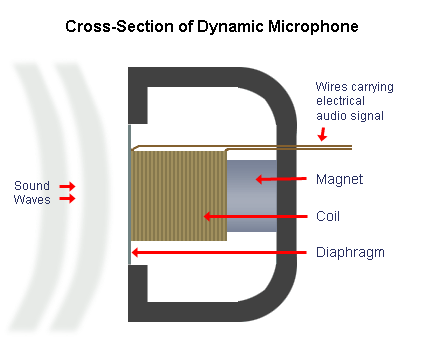Dynamic Microphones
Dynamic microphones are versatile and ideal for general-purpose use. They use a simple design with few moving parts. They are relatively sturdy and resilient to rough handling. They are also better suited to handling high volume levels, such as from certain musical instruments or amplifiers. They have no internal amplifier and do not require batteries or external power.
How Dynamic Microphones Work
As you may recall from your school science, when a magnet is moved near a coil of wire an electrical current is generated in the wire. Using this electromagnet principle, the dynamic microphone uses a wire coil and magnet to create the audio signal.
The diaphragm is attached to the coil. When the diaphragm vibrates in response to incoming sound waves, the coil moves backwards and forwards past the magnet. This creates a current in the coil which is channeled from the microphone along wires. A common configuration is shown below.

Earlier we mentioned that loudspeakers perform the opposite function of microphones by converting electrical energy into sound waves. This is demonstrated perfectly in the dynamic microphone which is basically a loudspeaker in reverse. When you see a cross-section of a speaker you'll see the similarity with the diagram above. If fact, some intercom systems use the speaker as a microphone. You can also demonstrate this effect by plugging a microphone into the headphone output of your stereo, although we don't recommend it!
Technical Notes:
Dynamics do not usually have the same flat frequency response as condensers. Instead they tend to have tailored frequency responses for particular applications.
Neodymium magnets are more powerful than conventional magnets, meaning that neodymium microphones can be made smaller, with more linear frequency response and higher output level.
Next Page: Condenser Microphones